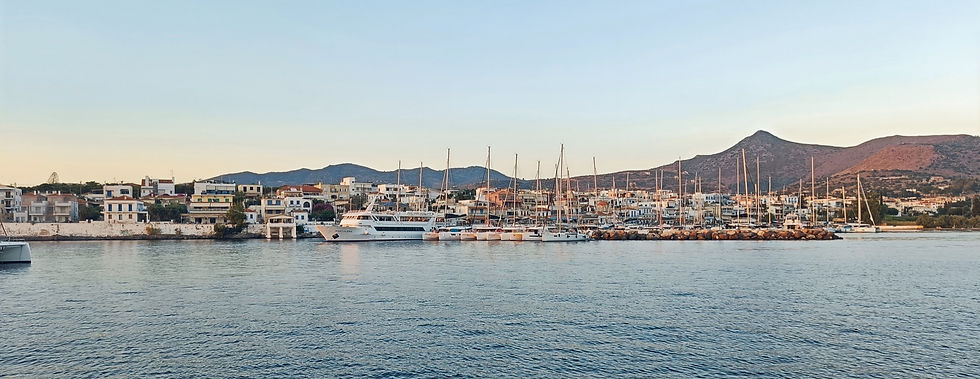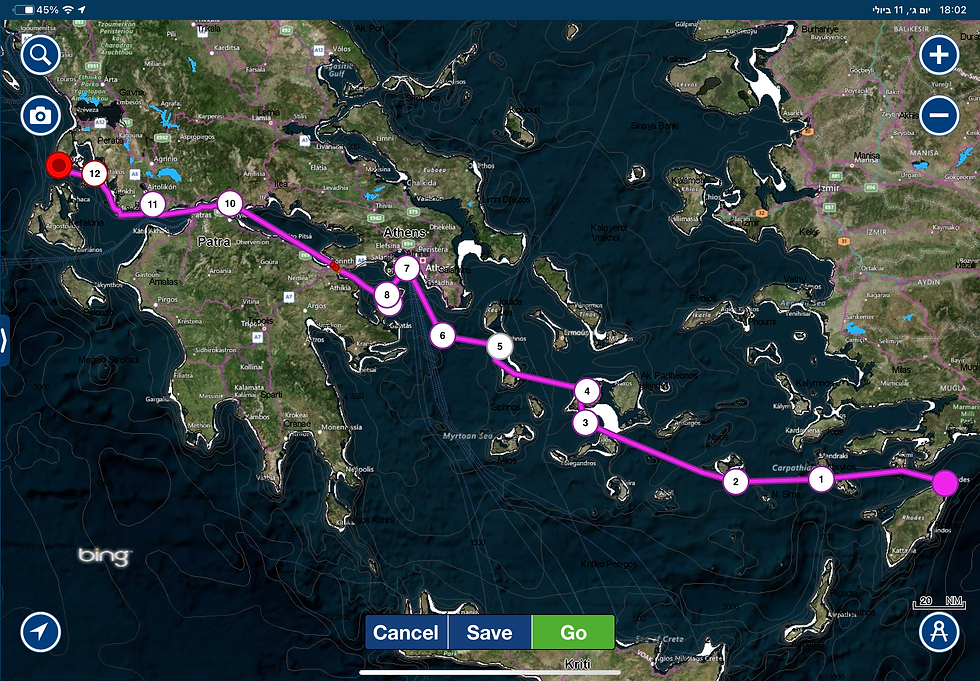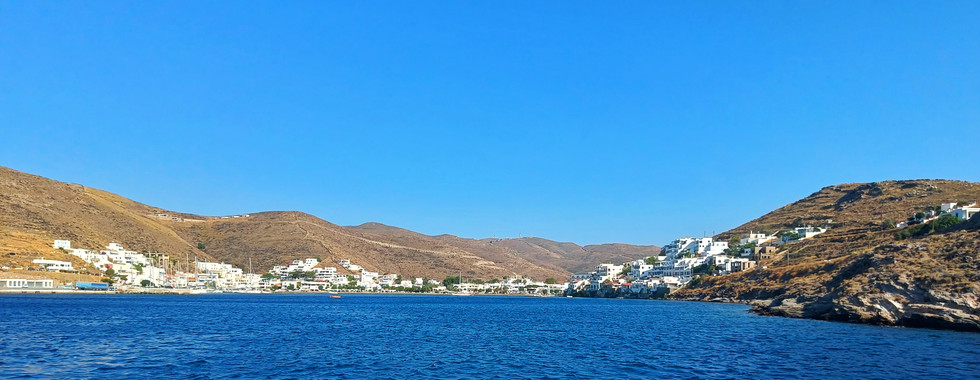Unplanned yacht delivery
- Sea4Soul

- Jul 7
- 17 min read
Introduction
After 25 years in the high-tech industry, including three years as an independent consultant, I began to feel burned out. The simple act of getting up in the morning became a struggle. I informed my clients I’d be ending my services in three months and set out to discover what would come next. Months went by with no spark. So, I decided to head to the sea – my happy place. Disconnected from phones and computers, I was sure I’d rediscover my passion there. I began searching for a delivery cruise to join. As a seasoned skipper and former Navy man, I knew I had a lot to offer.
A few days later, I stumbled across a post in a skipper's group: someone was looking for help transferring a boat from Rhodes to Corfu. I immediately opened Navionics to explore the route. I had the time, and everyone around me knows how much I love Greece. I just needed to confirm this was a legitimate trip and not something shady. After a few conversations with Yaniv, the boat's skipper, and aligning expectations, we agreed I would join. Yaniv mentioned that an unfamiliar couple and possibly his partner might also join. That worked well for me—less pressure to socialize, more time to reflect.
Sunday – July 2
I planned to fly out on July 2, but couldn’t find a flight. The earliest I could land in Rhodes was July 3 at 08:35. The day before the flight, Yaniv told me the boat’s owner still hadn’t given him power of attorney. We arranged to meet the owner at the airport at 05:30—he came all the way from Eilat. I got the documents, boarded my flight (which was delayed), and arrived at Rhodes Marina around 13:00.
Monday – Rhodes
The boat, a 2006 Lagoon 450, was dirty and neglected. We began cleaning. The couple went grocery shopping, Yaniv went to the coast guard, and I got to know the boat. Two things stood out: the bimini was torn, and the dinghy was deflated. Yaniv said a new dinghy was waiting in Athens. At 15:00, we fueled up and set sail. The sea was calm, but the wind came from our exact heading, so we motored. I took the first watch at the helm (which on the 450 is awkwardly disconnected from the boat), got sunburned quickly, and waited for evening. Originally, we planned to stop at Astypalaia, but knowing we wouldn’t make it, we decided to sail overnight straight to Paros. I went to bed at 22:00, came back up at 01:00, and Yaniv went down to sleep. Night sailing is always magical – starlit skies, total silence, a kind of meditation. Surprisingly, I had cell service all night, so I watched some movies, surfed a bit, and kept an eye on the route and autopilot. By 6:00 AM, the wind picked up to 35 knots with even stronger gusts. Short waves rocked the boat and slammed the bow, making sleep nearly impossible. But the sunrise made up for it.


Tuesday (Paros)
Around 2:00 PM, we entered the narrow channel between Paros and Antiparos. Heading north through this strait was nothing short of mesmerizing—boats of all shapes and sizes crisscrossing the waters, scattered rocky islets to watch out for, and charming whitewashed villages lining the shores of both islands.
We navigated carefully, and by 3:30 PM, after 24 hours of sailing, we docked in Paros Marina.
Without sunscreen on the second day as well, I was completely burnt. After securing the boat, I headed ashore to pick up some essentials—sunscreen, a wide-brimmed hat, new flip-flops—and of course, I couldn’t resist a fresh shawarma after a night of nothing but cornflakes.
When I returned to the boat, Yaniv’s partner invited me to join her at the beach. I’m not much of a beach person, but the heat on board (with no air conditioning) was unbearable, so I tagged along. We spent the afternoon cooling off at Livadia Beach—a neat little bay with water, chairs, and plenty of shade. It was the perfect escape from the relentless sun.
Socially, there still wasn’t much of a bond among the crew. Yaniv was keeping to himself, and the other couple mostly stayed in their cabin. So that evening, I headed out to grab dinner alone, while everyone else did their own thing.
Wednesday (Merichas, Kythnos)
We started the morning with a quick clean-up and supply run—Yaniv needed ropes, I went out to fetch fresh water.
The plan was to head toward Athens to pick up the missing dinghy, deciding along the way whether or not to stop at more islands. This was frustrating for me—our goal was to deliver the boat at a relaxed pace with stops at several islands. But as always, I went with the flow.
We left Paros and pointed the bow toward the entrance of the Saronic Gulf. The wind was, once again, right on the nose. We had two choices: motor or tack our way forward. Being an older catamaran model, she didn’t sail well upwind, so tacking would’ve cost us many extra hours. We chose the engine.
The sea was calm, and we cruised steadily at 6–7 knots. This time I had sunscreen and a hat, so the sun wasn’t a problem. After about 7.5 hours of motoring, we decided to drop anchor.
A quick glance at Navily showed the island of Kythnos nearby with several anchorages. Being a restaurant enthusiast, I preferred a proper marina over a wild bay, so we agreed to dock at the small village of Merichas.
Kythnos itself is barren and rugged, but dotted with beautiful little villages and lovely beaches.
When you sail slowly, the scenery reveals itself slowly. It took 15 minutes from the moment we entered the bay to fully take in the stunning village stretching along the coast—lined with tavernas right on the water.
To our luck, one final spot remained on the marina dock. We dropped anchor and gently maneuvered into place Mediterranean-style. The only downside was that due to the pier’s design, our gangway couldn’t fully reach the dock, so we had to pull the boat in manually each time we went ashore—a detail that would come back to haunt me the next morning.
Yaniv and his partner chose to dine alone, and the other couple went for a stroll. I stayed on board by myself. After a while, a strange American guy walking with a younger man and a dog struck up a conversation with me from the dock. After a few minutes, I invited them aboard for a beer and got to hear this fascinating man’s story.
He was a 60-year-old American who had divorced his wife after his kids grew up and had now been sailing solo with his dog for five years. He shared his life story, his divorce, and his future plans. We parted as friends.
Later, I headed to shore for dinner and bumped into the other couple, with whom I hadn’t connected much until then. They kindly invited me to join them so I wouldn’t feel alone, and I happily agreed. We had a fantastic dinner at a taverna on the bay—and that evening turned out to be the start of a beautiful friendship that’s still going strong, despite the age and experience gap (I’m the old guy).
We returned to the boat, had a great conversation at the bow, and then each of us headed to our cabins.
Thursday (Perdika, Aegina)
We planned to set off early to collect our new dinghy from a marina near Athens I had never even heard of. But at the scheduled departure time, the couple who had joined us were nowhere to be found. Apparently, they had gone off exploring (I won’t mention names out of respect for privacy).
We searched the island and eventually found them at a stunning beach we had discovered during our evening stroll the night before. We ran back to the boat and began lifting anchor—only to find the windlass struggling. A moment later, its fuse popped. Someone had dropped their anchor on top of ours.
We had two options: the usual trick of hauling up their anchor, tying it to our bow, and untangling things that way—or free diving down to 9 meters to resolve the tangle manually. Yaniv, being a skilled free diver, chose the latter. Without hesitation, he dove down and discovered that not one, but two anchors had landed over ours. He managed to move both, and we were finally free to get underway.
An hour behind schedule, we set a course for the designated marina, northwest of Piraeus. Once again, the sea was calm, but the wind—predictably northwesterly this time of year—was against us.
The sail itself was enjoyable. By now, we were all getting to know each other better, and the atmosphere on board had noticeably improved. Still, we weren’t quite a cohesive team—at least, not yet.
By late afternoon, we approached the port area of Piraeus, but we couldn’t locate the store that was supposed to supply us with the dinghy. Neither the shop owner nor the boat owner was answering their phones. With no other choice, we continued sailing and decided to spend the night in Aegina Town.
We reached the marina around 7:00 PM, only to find it completely full. Anchoring outside meant inflating the dinghy, heading to shore with the pump, finding dinner, and then inflating the dinghy again to get back aboard—an exhausting plan, especially with a dinghy motor that was acting up. I suggested we sail further south to the small village of Perdika on the southwest tip of Aegina.
We arrived, only to find the same situation—no berths available. Our options: tie up long side to the dozen other boats already rafted together, or drop anchor. We chose the latter.
Yaniv didn’t mind staying on board, but the other couple and I were eager to explore this charming little village. The man was full of energy, inflated the dinghy himself, and the three of us set off for the shore.
Perdika is a tiny village, with a main street lined with cozy tavernas, cafés, and bars.
We picked one and sat down. The waiter immediately pegged us as Israeli and started tossing around Hebrew phrases and name-dropping Israeli sailing instructors and yacht club owners.
Turns out he was the restaurant owner himself (in Greece, it’s perfectly normal for owners to wait tables), and a veteran captain for ZIM with over 35 years at sea. He showed us photos of his ship and truly spoiled us with his hospitality.
While in Perdika, we also met two Israeli families, chatted for a bit, then inflated the dinghy once more and headed back to the boat.
Once aboard, I asked Yaniv if he had arranged our transit through the Corinth Canal. He hadn’t. So I took the lead—opened the canal authority website, submitted our passage request, and paid the required fee.

Friday (Trizonia)
In the morning, we called the boat owner to ask about the dinghy. He told us it would be waiting in Missolonghi, a small and charming village in the Gulf of Patras, at the entrance to the Ionian Sea.
We started sailing toward the canal. Yaniv appointed me to handle communications for the crossing. Since we were still a bit far, I called the canal's control center. They said they hadn't received any request from our boat. I explained the situation, and they scolded us for submitting it so late. Still, they found the request in their system and asked us to contact them again two hours and one hour before arrival.
The sail toward the canal was quite comfortable. When we were about three miles from the entrance, I notified them we were waiting.
The Corinth Canal was originally envisioned by the Romans and is a 20-meter-wide passage that separates mainland Greece from the Peloponnese.
When our turn came, we were called in over the radio and joined the line of boats awaiting passage.
Crossing this impressive canal, which had just reopened two days earlier after repairs, was a memorable experience. It took a little over an hour, and on the other side, we entered the Gulf of Corinth. We had planned to head toward the village of Aigio, but after doing a bit of reading, I looked for a more appealing and maybe closer destination to reach before nightfall. After a quick search, I found the island of Trizonia. I called the marina contact on Navily, and he confirmed there was space—anchoring in the public marina was free, though there would be no electricity, water, or facilities.
Just off the coast of Delphi, the wind picked up and hit 30 knots. I knew the further west we sailed, the rougher the sea would get. The wind was against us again, and once more we faced a choice: engine or tacking. Given the conditions, we chose to get to the island as quickly as possible.
This is where we saw the largest pod of dolphins I've ever encountered—at least 30 of them! It was absolutely thrilling. Somewhere I’d read that the name "Delphi" might also be linked to the Greek word for dolphin due to the area's abundance of them.
As we approached the Rio-Antirrio bridge, the sea got rougher. The waves reached about 1.5 meters, short and choppy—similar to the Tiran Straits. Our bow slammed into each one, so we reduced speed and changed our angle to make things easier on the boat, though not on our nerves.
In heavy weather, with over 30 knots of wind and dense haze, we finally spotted the tiny island of Trizonia and entered its marina. The village sits just 600 meters from the mainland and is protected by a tall hill. By the time we docked, the wind had eased, and we went ashore to see what the island had to offer.
Besides a few tavernas, guesthouses, and motels, there wasn’t even a small minimarket. We could’ve survived without supplies, but we were nearly out of water—so finding bottled water became a priority. After a sunset stroll through this gorgeous island, we sat down at a taverna by the fishing harbor and enjoyed dinner.
During the meal, I noticed a small shuttle boat regularly arriving and departing from the island, carrying both people and supplies. I saw it delivering beer kegs to a bar, and that gave me an idea. I asked the skipper if he could buy us six packs of bottled water from the nearby village of Glyfada (yes, like the one in Athens) or even take me across to shop myself.
The skipper didn’t understand a word of English, but true to Greek hospitality, he brought me to the bar owner, who explained my request. Without hesitation, the skipper delivered six packs of water on his next trip—refusing payment for the service and charging only €8 for the water itself.
This kind of kindness is not new to me—it's something I experience nearly every visit to Greece. When a tourist asks for help, the locals won’t rest until the issue is resolved. And this wouldn’t be the last time it happened—Corfu would offer another similar encounter.
While we were still enjoying our meal, a small, older fishing boat docked right next to us. Suddenly, locals—and cats—rushed over. It turned out to be a local couple delivering fresh fish. Restaurant owners lined up to get their share, residents got bags of seafood, and even the cats, who clearly knew the boat well, each received a fish.
We returned to the boat, full and content—grateful to now have water aboard. The next morning, we’d be setting sail early toward Missolonghi, 36 miles from Trizonia, to collect the dinghy.
Saturday (Kastos)
We woke up to perfect weather. Trizonia looked stunning in the morning light, so we decided to have breakfast at the beach. We chose to sit at the café owned by the man who helped us with the water the night before—he truly appreciated the gesture. After breakfast and one more quick stroll, we set sail toward Missolonghi.
To reach Missolonghi, you have to pass under the Rio-Antirrio Bridge, which requires prior coordination and instructions over the radio. We received the necessary guidance and sailed through the impressive bridge.
The Rio-Antirrio Bridge, officially named the Charilaos Trikoupis Bridge, is a cable-stayed masterpiece that connects the mainland to the Peloponnese. At 2,882 meters long, with four pylons and five cable spans, it’s the longest fully suspended cable bridge in the world. It has four lanes, an emergency lane, and a pedestrian walkway.
Its namesake, Charilaos Trikoupis, was a prominent Greek prime minister in the late 19th century who first envisioned the bridge, though the technology of his time couldn’t support it.
This engineering marvel overcame challenges like deep waters, seismic activity, and unstable foundations—testament to Greek ingenuity.
The sail to Missolonghi was smooth, and we arrived just before noon. The city has a rich and fascinating history (which I won’t delve into here—Google it if you’re curious). But to access the town by sea, you must cross a shallow, swampy lagoon and the village of Tourlida, which felt like the backwaters of Mississippi.
Locals dug a narrow canal through the swamp to allow boat access to the town’s marina. When we arrived, the usual drama unfolded: the dinghy shop owner didn’t answer, the boat owner didn’t respond, and the private marina’s manager insisted we pay just to walk to the shop. Apparently, there’s a public marina on the opposite side of the bay, but we decided to move on—again, without our dinghy.
As we departed through the narrow and smelly canal, Yaniv—at the helm—must have drifted slightly into the swamp. Suddenly, the boat made strange noises and stirred up mud. I shouted for him to correct course. He did, but a moment later, the engine began overheating. We shut it off and continued on one engine, hoping the open sea would flush the cooling system.
Once we entered the Gulf of Patras, the wind and waves picked up again—35 knots of wind and 1.5-meter waves. The bow slammed repeatedly, making for an uncomfortable ride. We stayed indoors instead of the flybridge.
About an hour and a half in, we heard an alarm. The bilge float in the starboard hull had triggered. We checked and found over 40 cm of water in the bilge. Apparently, the bilge pumps on this older Lagoon only worked manually, and even then, the water didn’t drain. We suspected the engine cooling system might be leaking water into the bilge, so we shut off the starboard engine.
We saw no active water ingress, but as a precaution, we searched for the nearest safe harbor and decided on Kastos—an island south of Kalamos and southwest of Lefkada.
With pots and pans, we manually bailed the bilge and monitored the situation. The flooding stopped, but Yaniv opted not to restart the engine yet.
We arrived at the stunning village of Kastos around 8 p.m. Knowing strong winds were expected overnight, we looked for a med-mooring spot, but light was fading fast. We ended up anchoring and setting Anchor Lite apps on our phones for safety. We’d go ashore in the morning since we had no dinghy.
Sunday (Vasiliki, Lefkada)
The next morning, we checked the bilge—no new water. We started the starboard engine in neutral, and everything seemed fine. A closer daylight inspection suggested that the water might have entered through an unsealed hatch in the forward starboard cabin during the stormy days prior. The water had likely trickled along the hull into the bilge.
Regardless, Yaniv decided we’d head to Vasiliki in Lefkada to meet some friends of his partner’s, give the boat a thorough cleaning, and wrap up the delivery.
We inflated the dinghy and the couple and I went ashore to Kastos. We found a beachside taverna and had a rather mediocre, overpriced breakfast. Still, we enjoyed a pleasant walk around the picturesque village and picked up some groceries from the old local market.
Later that day, we sailed on—calm seas, no wind—and reached the beautiful bay of Vasiliki. The spacious marina offers water and electricity, though no showers or toilets. As with many such marinas, local supermarkets and restaurants provide those facilities for €3.
We went ashore, showered, did laundry, and grabbed a meal. Back on board with beers in hand, Yaniv officially announced that the delivery would end here. They had decided to stay in Vasiliki for the boat’s maintenance.
We had all booked one-way tickets, not knowing how long the delivery would take, so we now had to figure out how to get from Vasiliki to Corfu for a flight home. Surprisingly, that turned out to be more challenging than expected—there’s no public transportation from Vasiliki on Sundays, and not much on Mondays either.
Monday (Vasiliki - Lefkada City)
In the morning, we tried to find a way to reach Corfu. No ferries, no buses, and the only option to reach Lefkada City was by taxi. After some research, we discovered that there’s a bus from Lefkada City to Igoumenitsa, and from there a ferry to Corfu. We booked the taxi, bus, and ferry tickets, then moved on to booking our flights.
Surprisingly, getting a last-minute flight from Corfu to Israel wasn’t too hard—we found one for Tuesday at 1 p.m.
We spent the rest of the day enjoying the town, relaxing, and eating well. I even had one of the best shawarmas I’ve tasted in Greece (and I’ve tasted many).
Tuesday (Vasiliki - Lefkada City - Igoumenitsa - Corfu)
As planned, our taxi arrived on time. We had a quick breakfast, and just as we were heading back to the boat, the driver pulled up. We said goodbye to Yaniv and his partner and began our journey home.
We had really enjoyed this delivery, though personally, I wasn’t too fond of the Lagoon 450 in this configuration. The open flybridge is located above the main salon and galley, and to create entry space into the salon, the designers added a raised step—about 40 cm high and wide—right in the path from the cockpit stairs to the helm. You can’t access the flybridge from the starboard side, which is a problem. On calm seas, it’s manageable, but in choppier waters, that step becomes quite dangerous.
Another downside was the cramped, rounded toilets. Let’s just say round doesn’t fit well with a rounder backside, and tight spaces don’t suit larger folks. It made using the heads a challenge throughout the trip—unlike the Lagoon 42, where the heads and showers are much more spacious, even though the boat is 3 feet shorter.
Lastly, the design doesn't allow airflow to reach the cockpit well. Even on breezy days, it remained stuffy—but hey, we’re not picky.
The taxi ride to Lefkada City took around 45 minutes. The driver was incredibly kind, pointing out all the beautiful sites along the way. We passed every marina we had intended to anchor at, now experiencing them from the road.
We arrived at the bus terminal 20 minutes early, just enough time for a relaxed coffee. Then came a 2.5-hour bus ride to the city of Igoumenitsa, which lies west of the Tzoumerka region and southeast of Corfu.
The ride along highway E55 was winding and scenic, passing through typical Greek villages along the coast. I used the time to try and find us a hotel or guesthouse in Igoumenitsa, but it turned out most accommodations were fully booked. To my surprise, Booking.com listed a luxurious-looking guesthouse just minutes from the city center—for only $10 a night. I figured it was probably a mistake but booked it immediately.
Sure enough, just minutes later, the owner called me in a panic, apologizing for the pricing error. I hoped he’d offer us a fair discount, but he insisted on a much higher price. I thanked him, declined, and booked a different place a bit outside the city.
Igoumenitsa itself felt gray and uninviting—at least in the parts we saw.
We had lunch and headed to the port to catch our ferry.
The ferry was quite large (see photo), featuring spacious indoor lounges with chairs, tables, snack bars, and plenty of open-air benches. We settled in the air-conditioned area and then stepped outside for some photos. As we approached Corfu, the view became magical—fortresses, palaces, and of course, the massive superyachts of the global elite, docked along the coastline.
From the port, we grabbed a taxi to our guesthouse, just six minutes from the city center, located on a nameless street atop a hill.
We settled in, showered, got dressed, and headed out to explore Corfu’s old town. That’s when we hit a snag that turned into a heartwarming story.
Since the street had no name, taxi drivers couldn’t find it. The hostess didn’t speak English, so I walked about 300 meters to the main road to find the name and share it with taxi companies. Still, no one was willing to pick us up. Some dispatchers even hung up on us.
By 9:30 p.m., we were still stranded. We decided to walk down to the main road and hope to hail a taxi, but none came. (Tip: if you’re booking a guesthouse on a hill outside Corfu’s center—think twice.)
Just then, we noticed a wholesale produce warehouse still open. We stepped inside and found the entire family—mom, dad, and kids—running it. We asked if they could help us get a taxi. The son checked the bus schedule, but service had already ended. The father called several taxi stations, but none had cars available.
We thanked them and began walking away, but the father wouldn’t give up. Like a true Greek host, he insisted on helping. He called his high school friend, a taxi driver, but got no answer. Still, he asked us to wait. And sure enough, his friend called back a few minutes later, agreed to pick us up, and arrived promptly.
The driver explained that most taxi drivers prefer staying downtown rather than making a short six-minute drive uphill. He gave us his card and told us to call him when we were ready to return.
We explored the old town, had a great dinner, and called him afterward. He came right away. We also booked him for our airport ride the next morning. We thanked everyone who helped us that night and returned to our guesthouse, packed our bags and our memories, and turned in for our final night of the delivery.
Wednesday – End of the Delivery, Journey Home
Our taxi arrived on time, the flight took off as scheduled, and I had a lot to process. This journey was intense and meaningful, with two clear goals: to enjoy myself—and to rediscover my passion. A passion I’d lost five years before this delivery.
I said farewell to the lovely couple who had become lifelong friends—and returned home.
And if you’re wondering whether I found my passion again—well, this website is your answer. But it’s just one part of a much bigger plan that I’ll be revealing gradually.











































Comments